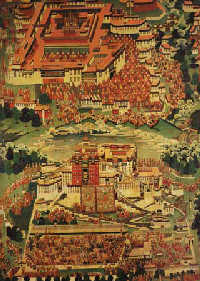|
Potala Palace
( 2005-10-27 )
 The remains of the 13th Dalai Lama are preserved in a stupa in the neighboring hall. The stupa is 0.86 meters lower than that of the 5th Dalai Lama, and has gold leaves made from more than 590 kilograms of gold. Construction of the hall, begun in 1933, was not completed until three years later. Thus it is the newest hall in the whole complex. The remains of the 13th Dalai Lama are preserved in a stupa in the neighboring hall. The stupa is 0.86 meters lower than that of the 5th Dalai Lama, and has gold leaves made from more than 590 kilograms of gold. Construction of the hall, begun in 1933, was not completed until three years later. Thus it is the newest hall in the whole complex.
The topmost hall in the Red Palace is called "The Best of the Three Realms" (Sasum Namgyal). It contains a portrait of the Qing Emperor Qianlong bearing the words "A long, long life to the present emperor" written in Han, Manchu, Mongol, and Tibetan. Dalai Lamas came to pay homage to this portrait on each Tibetan New Year's Day.
In the middle part of the Red Palace are the Dharma-raja's Cave (Chogyal Dupup) and several other apartments dating back from the reign of the Tubo Dynasty, the earliest Potala structures still extant. They house a valuable collection of statues, including the sculptural representation of King Songtsan Gambo, his consorts Tang Princess Wencheng and Nepalese Princess Khridzun, and his prime minister.
 Subordinate constructions Subordinate constructions
Subordinate constructions to the Potala include the Lamrgyal Abbey, the Senior Seminary, the monks' dormitories, and the eastern and western courtyards on the hill, while at the foot of the hill stands the houses once occupied by the local government bureaus and institutions; there is also a printing press for Buddhist canonical writings, as well as a jail, some stables, and a backyard garden.
For more than 300 years the Potala has accumulated an enormous collection of monuments and relics. There are murals covering totally more than 2,500 square meters, nearly 1,000 stupas, about 10,000 statues, and as many thangka (cloth-like) paintings. Also, the religious library there includes scriptures and volumes of Buddhists' Teachings.
There is also a unique collection of golden diplomas and jade seals that were granted to successive Dalai Lamas by Ming (1368-1644) and Qing (1644-1911) emperors to re-affirm the official ties between the local Tibetan administration and the Chinese Central Government. The gold and silver artifacts, porcelain vessels, enamelwork, jade ware, brocade, and other handicraft articles preserved in the Potala are enormous and richly diverse.
The Potala has been a sacred place for hundreds of years. Thousands of pilgrims from Tibet, other parts of China, and abroad come every year to pay homage. Their devotion is shown by the difficult journeys they have to make to reach their "Holy City."
After the peaceful liberation of Tibet in 1951, the Potala was listed as a cultural relic under the special protection of the State. Architecturally, it is considered as one of the wonders of the world -- admired by Chinese people and foreigners alike.
|

